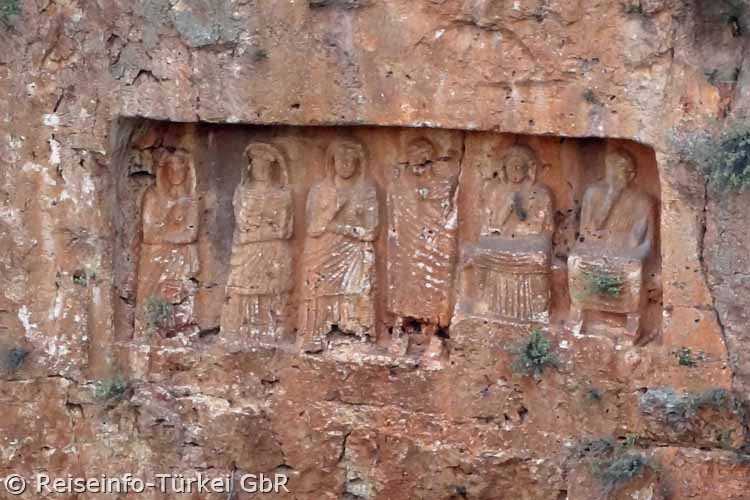|
Interesting places in Turkey |
|||
| In "Rough" Cilician |
|
||
| Kanytelleis | |||
| Ancient settlement on a collapse doline | |||
|
|
|||
|
|
|
||
| The Basilica IV | |||
|
|
|||
|
Kanytelleis (today Kanlidivane) is located about eight kilometers east of Kizkalesi, the ancient Korykos. The relics of the town are grouped around a collapse doline 70 m in diameter and 60 m deep, similar to the two karst collapses of the nearby Corycian caves (Cennet ve Cehennem) |
|||
|
|
|||
| Olbian fortified tower and basilica I | |||
|
The date of
foundation of the town is not known, but an inscription of the
Teukros from Olba found on the spot suggests that the town belonged
to the priestly state of Olba-Diokaisareia about 30 km to the
northwest in the second century BC. This is also indicated by the
Olbian symbol on the tower. |
|||
|
|
|||
| Olbian fortification and residential tower | |||
|
|
|||
|
The only evidence from pre-Christian times is a former three-storey high Hellenistic defence and residential tower on the southern edge of the doline, made of polygonal masonry with the aforementioned Olbian sign. A dedicatory inscription for Zeus Olbios points to the second century BC. |
|||
 |
|||
| Relief of the Armaronxas family | |||
|
|
|||
|
Two reliefs are embedded in the walls of the doline. On the south side there is an image of six members of the Armaronxas family (father, mother of their four children) and on the north side a portrait of a Roman warrior. |
|||
|
|
|||
| View through the twin windows of the apse of Basilica I | |||
|
|
|||
|
In the southwest
of the doline is the Byzantine Basilica I, a three-nave pillar
basilica with a length of 31 metres and a width of 18.40 metres,
which has been preserved in large parts. The narthex to the west
is accessed by a three-part archway, whose capitals are
decorated with large lobed acanthus leaves. |
|||
|
|
|||
| Hellenistic cistern | |||
|
If you walk around the doline in a clockwise direction, Basilica I is followed by a Turkish cemetery and a cistern from Hellenistic times |
|||
|
|
|||
| The Papylos Church (Basilica IV) | |||
|
According to an inscription by the founder, the three-nave Basilica IV Papylos Church, located in the northeast of the dolina, is called Papylos Church. It was built at the end of the fifth century and is the youngest and best preserved basilica of Kanytelleis. Most of the walls are still up to 8 metres high. |
|||
|
|
|||
| The south side of the Papylos Church | |||
|
Only the south
wall has completely broken away. In the west, the basilica is
preceded by a forecourt of 15 metres width and approximately 10
metres depth. Half an arch still stands from a three-part open
arch position, the western entrance to the 3.60 m deep and 14 m
wide narthex. |
|||
|
|
|||
|
120 m above Basilica IV is the so-called three-column tomb, measuring 4.1 x 5.7 metres, dating from the third and fourth centuries AD. Its special feature is that it has three columns instead of the usual four. The unadorned burial chamber is completely empty. |
|||
|
|
|||
| The temple grave of the Aba | |||
|
|
|||
|
Further west, at about the same level as the three-column tomb, is the temple tomb of the Aba, a wealthy lady who probably lost both her husband and her two sons in battle or in an epidemic. An inscription was placed on the archway, which contained both the name of the founder and the place name "Kanytelleis". |
|||
